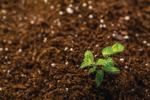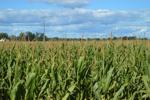Nitrogen management is one of the most challenging parts of agronomy because there are so many different loss pathways for the nutrient, and these loss pathways are all affected by the weather.
Extension soil fertility specialist Charlie White explains that the weather can also affect the rate of nitrogen mineralization, an important source of available nitrogen from soil organic matter, manure and cover crop residues.
Finally, economic efficiency with nitrogen applications is dependent on the cost of fertilizer and the price of the crop.
If you averaged out the temperature and moisture swings we’ve experienced this spring, we might be on track for an “average” weather year.
But underneath this average are several weeks of hot and dry weather followed by the recent week of cool and wet weather.
Has this variability affected your early-season nitrogen applications? And do the high prices of fertilizer and corn grain warrant an adjustment in nitrogen application rates?
With sidedress time quickly approaching, now would be a good time to take stock of the season so far to determine if any adjustments are needed.
The warm, dry weather we experienced early in the growing season may have affected nitrogen in various ways.
If you applied a urea-containing fertilizer (straight urea or urea ammonium nitrate solution, of which half of the nitrogen is in the urea form) during the dry period without a urease inhibitor and without incorporation into the soil, the risks for nitrogen losses through volatilization are relatively high.
Under worst-case scenarios, about 30% of untreated surface-applied urea can volatilize into the atmosphere.
UAN that is applied in a concentrated band usually soaks into the soil and has less risk of volatilization.
UAN applied as droplets in a spray, on the other hand, is at very high risk of volatilization without a urease inhibitor.
The urease inhibitors usually protect the urea from volatilization for about 2 weeks, during which time you hope to receive at least a half inch of rain to soak the urea into the soil.
Even if you treated urea or UAN with a urease inhibitor, if you did not receive a half inch of rain within two weeks of application, then the risk of nitrogen volatilization would start to go back up again.
Nitrogen Mineralization
The dry weather may have also affected nitrogen mineralization rates.
Soil that dries out significantly will start to have reduced microbial activity, and mineralization rates will slow down.
However, this slowdown from a moisture deficit could have been counteracted by the warm weather, which speeds up mineralization rates.
Farms that were able to maintain soil moisture through crop residue cover may have benefited from overall increased mineralization rates during the early part of the season due to the warm temperatures, while farms that had soils drying out probably experienced no significant difference from normal mineralization patterns.
The recent week of cool, wet weather has probably had a negligible overall effect on nitrogen mineralization and nitrogen losses compared to normal.
Although cool weather slows down microbial activity, soil temperatures are somewhat buffered from swings in air temperature due to the thermal mass of the soil.
The rain accompanying the cool weather also likely stimulated microbial activity after the dry period. So again, these counteracting effects probably have us on track for normal nitrogen mineralization rates in recent weeks.
Despite some localized heavy rainfall last week, it is unlikely to be enough to cause significant nitrogen leaching or denitrification losses.
Nitrogen Fertilization
Next you may be wondering how the high crop and nitrogen fertilizer prices might be affecting the economics of nitrogen fertilization.
In Pennsylvania, our nitrogen recommendations given in the Agronomy Guide do not factor in real-time variations in corn and fertilizer prices, as is done in many Midwestern states.
One of the reasons for this omission is we do not have as rich of a database of nitrogen response curves to develop recommendations from, and our nitrogen response curves tend to be more variable than in the Midwest due to greater variability in soil types and farming systems.
In analyzing a few nitrogen response curves from recent corn studies in Pennsylvania, however, White found that updating the price of grain and fertilizer from last year to this year reduced the economic optimum nitrogen rate by about 10 pounds of nitrogen per acre in most of the locations.
Given the margin of error in our nitrogen recommendations, this level of reduction in fertilizer suggested by current prices is probably not significant enough to act on.
It also tells White that if you suspect you experienced any early-season nitrogen losses from volatilization, unless those nitrogen losses were major, it probably won’t pay to try and replace those losses with any additional nitrogen beyond what you would typically use.
So, despite the gyrations in weather and the crazy behavior of the markets, from a nitrogen management perspective, White would encourage you to stay the course with your normal nitrogen program while striving for overall improvements where possible.
This includes using nitrogen stabilizers like urease inhibitors and nitrification inhibitors when it makes sense. More information is at bit.ly/Nstabilizer
You should also considering improving nitrogen application timing in corn production by sidedressing the majority of your nitrogen, which allows you to use adaptive tests like the pre-sidedress soil nitrate test and the chlorophyll meter test.
More details are at bit.ly/Nsidedress
And at the end of the growing season, consider using the late season corn stalk nitrate test (bit.ly/Nstalktest) to determine if your nitrogen applications were too little, too high or just right. This feedback will help you improve management in future years.
So, although White’s recommendation at this point in the season is to stay the course with your normal nitrogen program, it’s not because he opposes being as adaptive as possible in your management.
It’s just that being adaptive sometimes means that when situations are normal —or in this year’s case, when extremes might cancel each other out, resulting in something not too different than “normal” — continuing to do what you’ve learned works well for your system may still be the best option.
The Link LonkJune 08, 2021 at 05:15PM
https://ift.tt/3cJt4bt
Reviewing Your In-Season Nitrogen Management for Corn - Lancaster Farming
https://ift.tt/3gguREe
Corn




No comments:
Post a Comment